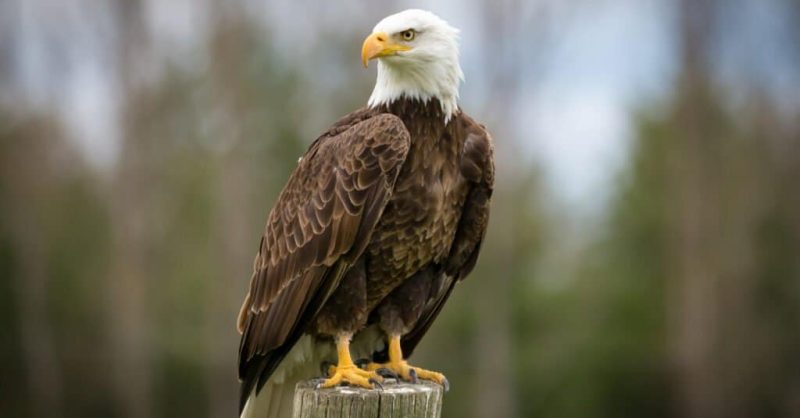Eagles are among the most powerful and admired birds of prey in North America. Known for their sharp eyesight, majestic flight, and strong hunting abilities, they have captured human fascination for centuries. In Kentucky, a state with vast forests, rolling hills, and extensive waterways, only two eagle species can be regularly observed—the Bald Eagle and the Golden Eagle. Although Kentucky is not home to as many eagle species as western regions of the United States, these two raptors hold special significance in the ecosystem and cultural landscape.
The Bald Eagle is well known as the national bird of the United States and has made a remarkable comeback in Kentucky after nearly disappearing due to habitat destruction and pesticide use. Today, sightings of Bald Eagles soaring above rivers and lakes have become increasingly common, especially during the winter months. On the other hand, the Golden Eagle, though less frequently seen, brings a sense of wilderness and mystery to Kentucky’s rugged terrain. Golden Eagles are mostly spotted in the Appalachian regions of eastern Kentucky during migration and wintering periods.
This guide explores the two types of eagles found in Kentucky in depth, with a focus on their identification, habitats, behaviors, and the best places to observe them. Whether you are a dedicated birdwatcher or simply someone interested in Kentucky’s wildlife, learning about these eagles will enrich your understanding of the state’s natural heritage.
The Bald Eagle in Kentucky

Characteristics and Physical Appearance
The Bald Eagle (Haliaeetus leucocephalus) is one of the most iconic birds in North America. Adults are instantly recognizable due to their striking white head and tail contrasting with a dark brown body and wings. Their powerful yellow beak and piercing eyes add to their fierce expression. Juvenile Bald Eagles, however, are mostly brown with mottled white patches and do not acquire the signature white head and tail until they are about four to five years old. This gradual change in plumage often confuses observers who may mistake young eagles for other large raptors.
Bald Eagles are large birds, with wingspans that can reach up to seven feet. Males are slightly smaller than females, but both exhibit the same coloration and features. Their broad wings allow them to soar effortlessly for long periods, using thermal currents to conserve energy. This gliding ability often makes them appear graceful despite their size and strength.
Habitat and Range in Kentucky
Bald Eagles are closely tied to bodies of water. In Kentucky, they are most often seen near rivers, lakes, and reservoirs where fish are abundant. The large lakes of western Kentucky, including Kentucky Lake and Lake Barkley, provide ideal habitats for nesting and foraging. These areas attract both resident pairs and migratory eagles that arrive during the colder months when northern waters freeze over.
Historically, Bald Eagles were rare in Kentucky, but conservation efforts, including habitat protection and restrictions on harmful chemicals like DDT, have allowed their populations to rebound. Today, Kentucky hosts nesting pairs across the state, and the number continues to grow each year. Birdwatchers can often find them perched on tall trees overlooking the water, waiting patiently to swoop down and snatch fish near the surface.
Hunting and Feeding Behavior
The Bald Eagle’s diet is dominated by fish, but they are also opportunistic hunters and scavengers. In Kentucky, they hunt species such as shad and catfish, often catching them directly from the water with their sharp talons. They are strong enough to lift fish weighing several pounds, though they sometimes struggle to carry overly large prey and may drop it mid-flight.
Besides fishing, Bald Eagles also feed on waterfowl, small mammals, and carrion. They are known for stealing food from other birds, especially Ospreys, in a behavior called kleptoparasitism. By harassing Ospreys mid-air, Bald Eagles often force them to release their freshly caught fish, which the eagle then retrieves before it hits the water. This bold strategy demonstrates their dominance as apex predators within their habitats.
Nesting and Breeding in Kentucky
Bald Eagles build some of the largest nests in the bird world, often using the same site year after year and adding new materials each season. Nests can be as wide as eight feet across and weigh hundreds of pounds. In Kentucky, nests are typically located high in tall trees near water, providing a safe vantage point for raising young.
Breeding usually begins in late winter, with eggs laid between January and March. Pairs are monogamous and mate for life, returning to the same nesting area annually. Both parents share responsibilities of incubating eggs and feeding the eaglets once they hatch. By late spring, young eagles fledge but remain dependent on their parents for several weeks as they learn to hunt.
The Golden Eagle in Kentucky

Identification and Physical Traits
The Golden Eagle (Aquila chrysaetos) is one of the most powerful raptors in the world and has a very different appearance from the Bald Eagle. Instead of a white head, Golden Eagles are uniformly dark brown with golden feathers on the back of the neck, giving them their name. Their eyes are dark, and their beaks are black with a yellow base. In flight, their long, broad wings often show faint lighter patches, especially in young birds.
Golden Eagles are slightly larger on average than Bald Eagles, with wingspans that can also reach seven feet. Their wings are narrower, and their flight style is more direct and powerful. Unlike Bald Eagles, which rely heavily on fish, Golden Eagles are skilled hunters of mammals and birds, making them fierce predators across their range.
Seasonal Presence in Kentucky
Golden Eagles are not permanent residents in Kentucky, but they appear during migration and the winter months. Most individuals migrate from northern breeding grounds in Canada and the western United States. In Kentucky, they are most frequently observed in the Appalachian Mountains, particularly in remote forested areas of the eastern part of the state.
The rugged terrain of eastern Kentucky provides the isolation and habitat structure that Golden Eagles prefer. Steep ridges, cliffs, and expansive forests mimic the landscapes where they thrive in other parts of North America. Although sightings are relatively rare compared to Bald Eagles, Kentucky provides critical wintering grounds for these birds.
Hunting and Diet
Golden Eagles are versatile hunters that primarily feed on mammals such as rabbits, squirrels, and groundhogs. In Kentucky, they may also take wild turkeys and other birds when available. Unlike Bald Eagles, they rarely scavenge and instead rely on their strength, speed, and stealth to capture live prey. They can dive at incredible speeds, striking with precision and using their powerful talons to kill animals much larger than themselves.
During winter in Kentucky, when prey may be scarce, Golden Eagles sometimes feed on carrion, especially deer carcasses left behind by hunters or natural causes. This opportunistic behavior helps them survive during times of limited food supply. However, their primary hunting abilities remain unmatched, placing them among the most formidable predators in the avian world.
Behavior and Conservation Status
Golden Eagles are solitary birds outside of the breeding season, unlike Bald Eagles, which may gather in groups near food sources. In Kentucky, they are usually seen alone or in pairs during the colder months. Their secretive nature makes them difficult to observe, adding to their mystique among bird enthusiasts.
In terms of conservation, Golden Eagles are protected under the Migratory Bird Treaty Act. While their populations remain stable across much of North America, habitat loss and human disturbance remain concerns. For Kentucky, preserving forested ridges and maintaining large tracts of wild land are essential for ensuring their continued presence during migration and wintering periods.
Where to See Eagles in Kentucky
Kentucky’s geography provides excellent opportunities to view both Bald and Golden Eagles. Bald Eagles are most reliably seen near large lakes such as Kentucky Lake, Lake Barkley, and Cave Run Lake, where they perch on tall snags or soar above open water. The Land Between the Lakes National Recreation Area has become one of the best destinations in the state for eagle watching, with organized eagle tours offered during the winter months.
Golden Eagles, being rarer, require more effort to spot. They are most likely found in the eastern Kentucky mountains, particularly in the Daniel Boone National Forest. Birdwatchers who venture into remote areas during winter have a better chance of seeing these majestic raptors. Using binoculars and scanning ridgelines for soaring eagles is often the most effective method.
Both species highlight the diversity of Kentucky’s birdlife and reflect the importance of conservation efforts that have allowed these top predators to thrive once again. Their presence also indicates healthy ecosystems, as eagles require abundant prey and large undisturbed habitats to survive.
The Importance of Eagles in Kentucky’s Ecosystem
Eagles play an essential role in maintaining ecological balance. As apex predators, they regulate populations of fish, birds, and small mammals. This helps prevent overpopulation and supports the health of natural systems. Their scavenging habits also contribute to the ecosystem by cleaning up carrion, which reduces the spread of disease.
Beyond their ecological role, eagles have cultural and symbolic importance. The Bald Eagle, in particular, embodies strength and freedom, serving as the national emblem of the United States. In Kentucky, its recovery represents a triumph of wildlife conservation and a reminder of the importance of protecting natural habitats.
The Golden Eagle, although less familiar to the general public, is equally significant. Its presence in Kentucky reflects the state’s role as part of a broader migratory network that sustains these wide-ranging birds. Protecting Kentucky’s forests and wild lands ensures that Golden Eagles will continue to find refuge during the winter months.
Conclusion
Only two types of eagles can be found in Kentucky—the Bald Eagle and the Golden Eagle—but their presence is powerful and inspiring. The Bald Eagle, once on the brink of extinction, now thrives along Kentucky’s waterways, symbolizing resilience and the success of conservation. The Golden Eagle, though more elusive, brings a sense of wilderness to the state’s rugged mountains, reminding us of the deep connections between Kentucky and the broader natural world.
For birdwatchers, naturalists, and residents alike, seeing one of these raptors in the wild is a breathtaking experience. Whether soaring over a lake or gliding along a mountain ridge, eagles capture the spirit of freedom and strength that resonates deeply in Kentucky’s natural heritage. Protecting their habitats and ensuring their survival is not only an environmental duty but also a cultural legacy for future generations.
FAQs about Eagles in Kentucky
How many types of eagles live in Kentucky?
Kentucky is home to two eagle species: the Bald Eagle and the Golden Eagle. The Bald Eagle is the more common of the two and can be found year-round, while the Golden Eagle is a winter visitor, mostly in the Appalachian regions.
Where is the best place to see eagles in Kentucky?
The best places to spot Bald Eagles are near Kentucky Lake, Lake Barkley, and Cave Run Lake. For Golden Eagles, the Daniel Boone National Forest and eastern Appalachian mountains are prime wintering habitats.
Do Bald Eagles nest in Kentucky?
Yes, Bald Eagles nest in Kentucky, especially around large lakes and rivers. Their massive nests are often built in tall trees overlooking the water, and the number of breeding pairs has steadily increased in recent decades.
Are Golden Eagles rare in Kentucky?
Golden Eagles are much rarer than Bald Eagles in Kentucky. They do not nest in the state but migrate through and spend winters in the mountainous eastern regions. Sightings are infrequent but possible for patient birdwatchers.
What do eagles eat in Kentucky?
Bald Eagles primarily feed on fish, though they also eat waterfowl, small mammals, and carrion. Golden Eagles hunt rabbits, squirrels, and other mammals, but in winter they may scavenge on deer carcasses to survive.
Are eagles protected in Kentucky?
Yes, both Bald Eagles and Golden Eagles are protected under federal law. It is illegal to harm, harass, or disturb them, and their habitats are safeguarded to ensure their survival in Kentucky.






